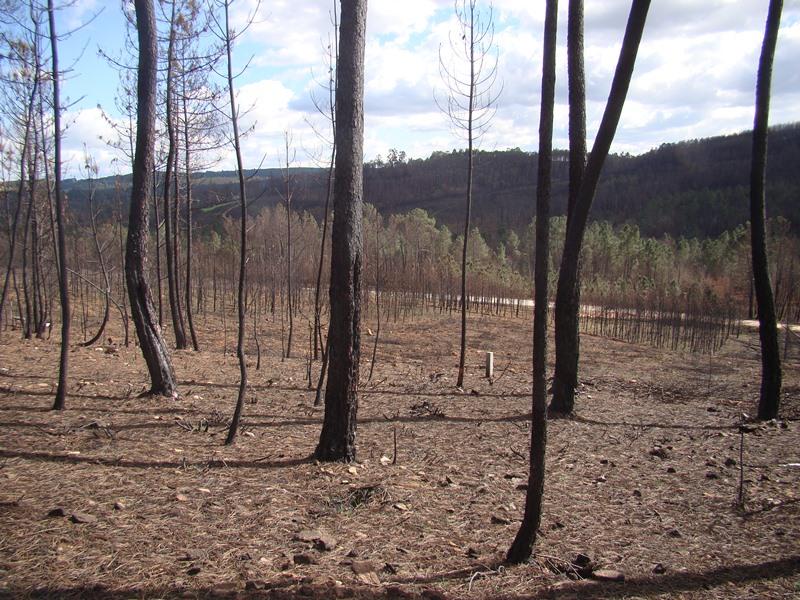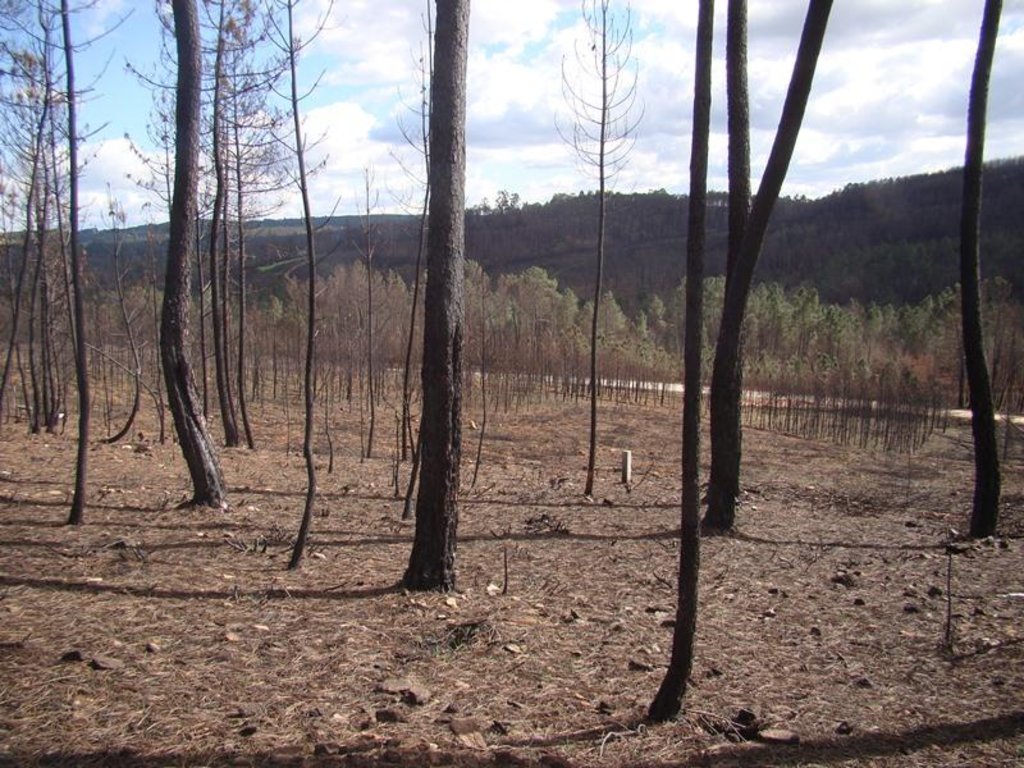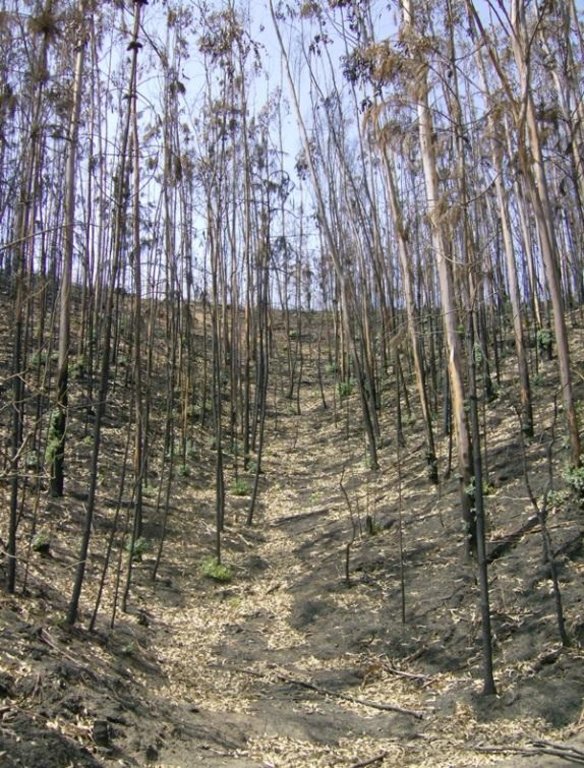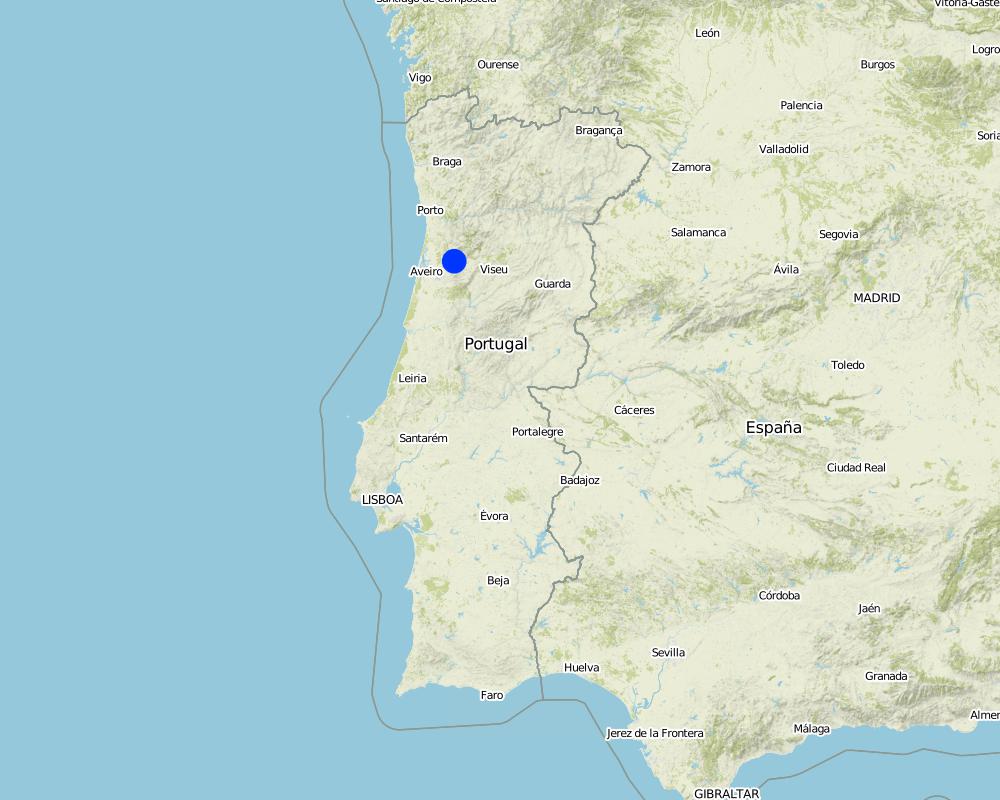Post-fire Natural Mulching [Portugal]
- Creation:
- Update:
- Compiler: Sergio Prats Alegre Prats
- Editor: –
- Reviewers: Fabian Ottiger, Alexandra Gavilano
No intervention, needle carpet, caruma (Portuguese)
technologies_1298 - Portugal
View sections
Expand all Collapse all1. General information
1.2 Contact details of resource persons and institutions involved in the assessment and documentation of the Technology
SLM specialist:
SLM specialist:
Keizer Jan Jacob
Centre for Environmental and Marine Studies (CESAM) - Department of Environment and Planning-University of Aveiro
Portugal
SLM specialist:
Name of project which facilitated the documentation/ evaluation of the Technology (if relevant)
Preventing and Remediating degradation of soils in Europe through Land Care (EU-RECARE )Name of project which facilitated the documentation/ evaluation of the Technology (if relevant)
Catastrophic shifts in drylands (EU-CASCADE)Name of the institution(s) which facilitated the documentation/ evaluation of the Technology (if relevant)
University of Aveiro (University of Aveiro) - PortugalName of the institution(s) which facilitated the documentation/ evaluation of the Technology (if relevant)
Fundação para a Ciência e a Tecnologia (FCT) - Portugal1.3 Conditions regarding the use of data documented through WOCAT
The compiler and key resource person(s) accept the conditions regarding the use of data documented through WOCAT:
Yes
2. Description of the SLM Technology
2.1 Short description of the Technology
Definition of the Technology:
In certain situations, the leaves from the burnt trees created a natural carpet that protect the soil from being eroded.
2.2 Detailed description of the Technology
Description:
In the 2007 summer a wildfire affected the locality of Pessegueiro do Vouga, municipality of Sever do Vouga, north-central Portugal. The area was afforested with eucalypt and pine plantations. The research team of the University of Aveiro checked that in some burnt areas the crown damage was very small, despite the litter and underground vegetation were totally consumed by fire. The pine site presented a markedly lower fire severity, with the canopies only partially consumed by the fire, so it allow to study the effect of fire severity on soil erosion by comparison with adjacent slopes burned a high severity.
Purpose of the Technology: In a wildfire that affected a pine plantation in central Portugal in 2007, the research team of the University of Aveiro set up an experiment in order to test the effect of forest residue mulching as a soil erosion mitigation treatment. However, the low fire severity resulted in an elevated litter cover prior any technique was applied. The objective is to determine were “no action” in post-fire management will still result in low soil erosion values.
Establishment / maintenance activities and inputs: The high litter cover will decrease post-fire soil erosion by reducing raindrop impact over the ashes and the bare soil, and decrease the runoff amount by increasing water surface storage, decrease of runoff velocity, and increase infiltration. As the needle litter cover was natural, no action was needed. After a simple assessment of the remaining ground cover in the burnt area, the "no intervention" option should be selected if the soil is covered by litter, leaves or needles. The benefits of this are not only the mitigation of soil erosion (and associated soil fertility losses) immediately after forest fires, but also the long-term conservation of the soil resources without additional costs.
Natural / human environment: The landscape reflects a long history of intense land management, with a mosaic of (semi-)natural and man-made agricultural and afforested lands. Since the 1980´s, however, wildfires have increased dramatically in frequency and extent, aided by a general warming and drying trend but driven primarily by socio-economic changes.
2.3 Photos of the Technology
2.5 Country/ region/ locations where the Technology has been applied and which are covered by this assessment
Country:
Portugal
Region/ State/ Province:
Portugal, Aveiro
Further specification of location:
Sever do Vouga, Pessegueiro de Vouga
Specify the spread of the Technology:
- evenly spread over an area
If precise area is not known, indicate approximate area covered:
- < 0.1 km2 (10 ha)
Comments:
Total area covered by the SLM Technology is 1.0E-5 m2.
Map
×2.6 Date of implementation
If precise year is not known, indicate approximate date:
- less than 10 years ago (recently)
2.7 Introduction of the Technology
Specify how the Technology was introduced:
- during experiments/ research
3. Classification of the SLM Technology
3.2 Current land use type(s) where the Technology is applied

Forest/ woodlands
- Tree plantation, afforestation
Type of tree:
- Pinus species (pine)
Products and services:
- Timber
- Fuelwood
Comments:
Major land use problems (compiler’s opinion): Strong increases in runoff and erosion should be a main land management concern following wildfires, as they constitute a serious threat to land-use sustainability and downstream aquatic habitats and human infrastructures. The forest owners and managers need to establish target areas to apply cost-effective post-fire soil erosion mitigation treatments, included the “no action” option.
Major land use problems (land users’ perception): Loss of wood resources and productivity.
Plantation forestry: Pines logged every 30 years, after fire natural regeneration if possible, but mainly after fire there is a change to eucalypt plantations
Forest products and services: timber, fuelwood
Number of growing seasons per year: 3
Longest growing period in days: 270Longest growing period from month to month: September to May
3.5 SLM group to which the Technology belongs
- improved ground/ vegetation cover
3.6 SLM measures comprising the Technology

agronomic measures
- A1: Vegetation/ soil cover
Comments:
Secondary measures: agronomic measures
Type of agronomic measures: mulching
3.7 Main types of land degradation addressed by the Technology

soil erosion by water
- Wt: loss of topsoil/ surface erosion
- Wo: offsite degradation effects

physical soil deterioration
- Pk: slaking and crusting
Comments:
Main type of degradation addressed: Wt: loss of topsoil / surface erosion
Secondary types of degradation addressed: Wo: offsite degradation effects, Pk: sealing and crusting
Main causes of degradation: soil management (Land use change has been associated to increasing fire frequency in the region), deforestation / removal of natural vegetation (incl. forest fires) (Pine plantations are prone to fire), population pressure (Since the 80´s land use had change to increase afforestation with flammable species (i.e. pine and eucalypts))
3.8 Prevention, reduction, or restoration of land degradation
Comments:
Main goals: prevention of land degradation, mitigation / reduction of land degradation
Secondary goals: rehabilitation / reclamation of denuded land
4. Technical specifications, implementation activities, inputs, and costs
4.1 Technical drawing of the Technology
Technical specifications (related to technical drawing):
Natural mulch is often present in areas burnt at low severity or only partially burnt (3). This areas as well as planar areas (2) must be areas for no mitigation treatment or “no action” after forest fires.
Main technical functions: control of raindrop splash, control of dispersed runoff: retain / trap, control of concentrated runoff: retain / trap, improvement of ground cover, increase of surface roughness, increase of infiltration, sediment retention / trapping, sediment harvesting, increase of biomass (quantity)
Secondary technical functions: control of dispersed runoff: impede / retard, control of concentrated runoff: impede / retard, improvement of surface structure (crusting, sealing), improvement of topsoil structure (compaction), increase in organic matter, increase in nutrient availability (supply, recycling,…), increase / maintain water stored in soil
Mulching
Material/ species: natural needle carpet
Remarks: Up to 50% litter cover
4.3 Establishment activities
| Activity | Timing (season) | |
|---|---|---|
| 1. | Natural cover |
4.7 Most important factors affecting the costs
Describe the most determinate factors affecting the costs:
No cost are envisaged for this technology. Visual assessment of the soil cover can be susceptible for costs, for example consulting, but we think it is not eligible.
5. Natural and human environment
5.1 Climate
Annual rainfall
- < 250 mm
- 251-500 mm
- 501-750 mm
- 751-1,000 mm
- 1,001-1,500 mm
- 1,501-2,000 mm
- 2,001-3,000 mm
- 3,001-4,000 mm
- > 4,000 mm
Agro-climatic zone
- humid
- sub-humid
Thermal climate class: subtropics
Thermal climate class: temperate
5.2 Topography
Slopes on average:
- flat (0-2%)
- gentle (3-5%)
- moderate (6-10%)
- rolling (11-15%)
- hilly (16-30%)
- steep (31-60%)
- very steep (>60%)
Landforms:
- plateau/plains
- ridges
- mountain slopes
- hill slopes
- footslopes
- valley floors
Altitudinal zone:
- 0-100 m a.s.l.
- 101-500 m a.s.l.
- 501-1,000 m a.s.l.
- 1,001-1,500 m a.s.l.
- 1,501-2,000 m a.s.l.
- 2,001-2,500 m a.s.l.
- 2,501-3,000 m a.s.l.
- 3,001-4,000 m a.s.l.
- > 4,000 m a.s.l.
5.3 Soils
Soil depth on average:
- very shallow (0-20 cm)
- shallow (21-50 cm)
- moderately deep (51-80 cm)
- deep (81-120 cm)
- very deep (> 120 cm)
Soil texture (topsoil):
- medium (loamy, silty)
Topsoil organic matter:
- high (>3%)
If available, attach full soil description or specify the available information, e.g. soil type, soil PH/ acidity, Cation Exchange Capacity, nitrogen, salinity etc.
Topsoil organic matter is high (forest soil)
Soil fertilits is medium
Soil drainage/infiltration is medium - poor (fire reduce soil infiltration capacity. Also, soil water repellency is present).
Soil water storage capacity is low
5.4 Water availability and quality
Ground water table:
> 50 m
Availability of surface water:
medium
Water quality (untreated):
good drinking water
5.5 Biodiversity
Species diversity:
- low
Comments and further specifications on biodiversity:
Forest plantation
5.6 Characteristics of land users applying the Technology
Off-farm income:
- 10-50% of all income
Relative level of wealth:
- poor
- average
Individuals or groups:
- groups/ community
Gender:
- women
- men
Indicate other relevant characteristics of the land users:
Land users applying the Technology are mainly common / average land users
Population density: 50-100 persons/km2
40% of the land users are average wealthy and own 30% of the land.
60% of the land users are poor and own 70% of the land.
Market orientation of production system: subsistence (self-supply), mixed (subsistence/ commercial, commercial/ market
5.7 Average area of land used by land users applying the Technology
- < 0.5 ha
- 0.5-1 ha
- 1-2 ha
- 2-5 ha
- 5-15 ha
- 15-50 ha
- 50-100 ha
- 100-500 ha
- 500-1,000 ha
- 1,000-10,000 ha
- > 10,000 ha
Is this considered small-, medium- or large-scale (referring to local context)?
- small-scale
Comments:
Average area of land owned or leased by land users applying the Technology: 2-5 ha, 5-15 ha, 15-50 ha
5.8 Land ownership, land use rights, and water use rights
Land ownership:
- company
- individual, not titled
5.9 Access to services and infrastructure
health:
- poor
- moderate
- good
education:
- poor
- moderate
- good
technical assistance:
- poor
- moderate
- good
employment (e.g. off-farm):
- poor
- moderate
- good
markets:
- poor
- moderate
- good
energy:
- poor
- moderate
- good
roads and transport:
- poor
- moderate
- good
drinking water and sanitation:
- poor
- moderate
- good
financial services:
- poor
- moderate
- good
6. Impacts and concluding statements
6.1 On-site impacts the Technology has shown
Socio-economic impacts
Production
wood production
Comments/ specify:
Some reduced wood production can be associated to the technique by carrying out selective felling.
Socio-cultural impacts
SLM/ land degradation knowledge
Comments/ specify:
Public awareness of the technology is very limited. It is necessary to show it to landowners and stakeholders and increase dissemination.
Improved livelihoods and human well-being
Ecological impacts
Water cycle/ runoff
surface runoff
evaporation
Soil
soil moisture
soil cover
soil loss
soil crusting/ sealing
soil compaction
Climate and disaster risk reduction
fire risk
6.2 Off-site impacts the Technology has shown
downstream flooding
damage on neighbours' fields
damage on public/ private infrastructure
6.3 Exposure and sensitivity of the Technology to gradual climate change and climate-related extremes/ disasters (as perceived by land users)
Gradual climate change
Gradual climate change
| Season | increase or decrease | How does the Technology cope with it? | |
|---|---|---|---|
| annual temperature | increase | well |
Climate-related extremes (disasters)
Meteorological disasters
| How does the Technology cope with it? | |
|---|---|
| local rainstorm | not well |
| local windstorm | well |
6.4 Cost-benefit analysis
How do the benefits compare with the establishment costs (from land users’ perspective)?
Short-term returns:
very positive
Long-term returns:
very positive
How do the benefits compare with the maintenance/ recurrent costs (from land users' perspective)?
Short-term returns:
very positive
Long-term returns:
very positive
Comments:
As natural mulching has no cost, any benefit is always very positive
6.5 Adoption of the Technology
Comments:
Comments on spontaneous adoption: The land users are not aware about the advantages of natural mulching, but in fact they apply it when they have not economic resources.
There is a moderate trend towards spontaneous adoption of the Technology
Comments on adoption trend: Some times logging after fire reduces the natural mulching capacity to prevent post-fire erosion
6.7 Strengths/ advantages/ opportunities of the Technology
| Strengths/ advantages/ opportunities in the land user’s view |
|---|
| No cost |
| Strengths/ advantages/ opportunities in the compiler’s or other key resource person’s view |
|---|
|
It is a technology with no associated cost and with low failure possibilities and a strong soil erosion control. How can they be sustained / enhanced? Inform land owners and forest managers to avoid post-fire logging in areas with natural mulching and therefore avoid the decrease in the technology effeciency. Some times logging after fire reduces the natural mulching capacity to prevent post-fire erosion. |
6.8 Weaknesses/ disadvantages/ risks of the Technology and ways of overcoming them
| Weaknesses/ disadvantages/ risks in the land user’s view | How can they be overcome? |
|---|---|
| No possible to harvest the logs during the first period after the fire | Assume the cost of selective felling |
| Weaknesses/ disadvantages/ risks in the compiler’s or other key resource person’s view | How can they be overcome? |
|---|---|
| Some people argue that can increase fire risk | Fire risk will not be probably increase as the surrounded areas were frequently also burned |
7. References and links
7.1 Methods/ sources of information
7.2 References to available publications
Title, author, year, ISBN:
Prats SA, MacDonald LH, Monteiro M, Ferreira AJD, Coelho COA, KeizerJJ. 2012. Effectiveness of forest residue mulching in reducing post-firerunoff and erosion in a pine and a eucalypt plantation in north-centralPortugal. Geoderma 191: 115–124.
Title, author, year, ISBN:
Shakesby RA, Boakes JD, Coelho COA, Bento-Gonçalves JA, Walsh RPD.1996. Limiting the soil degradational impacts of wildfire in pine and eucalyptusforests in Portugal. Applied Geography 16: 337–355.
Title, author, year, ISBN:
RECARE project: Preventing and Remediating degradation of soils in Europe trhough Land Care. http://www.recare-project.eu/
Links and modules
Expand all Collapse allLinks
No links
Modules
No modules






